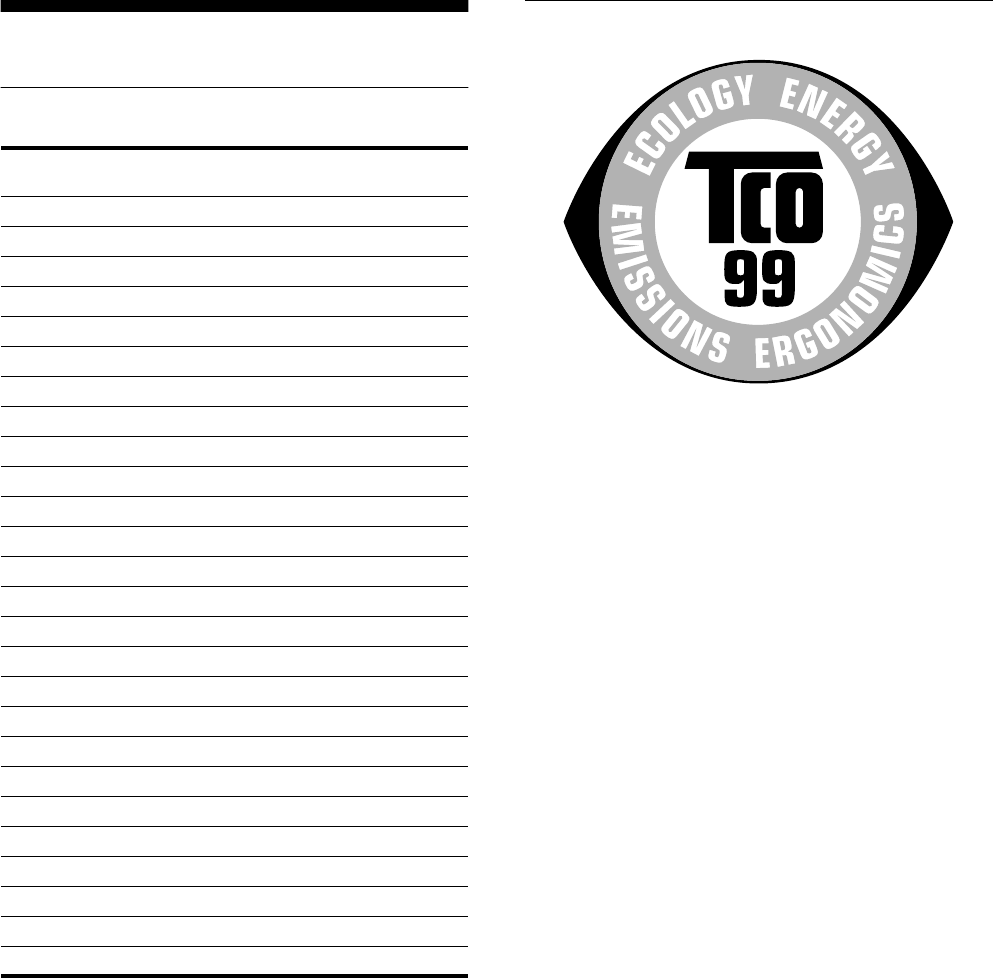
i
Appendix
Preset mode timing table
If the input signal does not match one of the factory preset modes
above, the Generalized Timing Formula feature of this monitor
will automatically provide an optimal image for the screen as long
as the signal is GTF compliant.
TCO’99 Eco-document
x
Congratulations!
You have just purchased a TCO’99 approved and labelled
product! Your choice has provided you with a product developed
for professional use. Your purchase has also contributed to
reducing the burden on the environment and also to the further
development of environmentally adapted electronics products.
x
Why do we have environmentally labelled
computers?
In many countries, environmental labelling has become an
established method for encouraging the adaptation of goods and
services to the environment. The main problem, as far as
computers and other electronics equipment are concerned, is that
environmentally harmful substances are used both in the products
and during their manufacture. Since it is not so far possible to
satisfactorily recycle the majority of electronics equipment, most
of these potentially damaging substances sooner or later enter
nature.
There are also other characteristics of a computer, such as energy
consumption levels, that are important from the viewpoints of
both the work (internal) and natural (external) environments.
Since all methods of electricity generation have a negative effect
on the environment (e.g. acidic and climate-influencing
emissions, radioactive waste), it is vital to save energy.
Electronics equipment in offices is often left running
continuously and thereby consumes a lot of energy.
x
What does labelling involve?
This product meets the requirements for the TCO’99 scheme
which provides for international and environmental labelling of
personal computers. The labelling scheme was developed as a
joint effort by the TCO (The Swedish Confederation of
Professional Employees), Svenska Naturskyddsforeningen (The
Swedish Society for Nature Conservation) and Statens
Energimyndighet (The Swedish National Energy
Administration).
Approval requirements cover a wide range of issues:
environment, ergonomics, usability, emission of electric and
magnetic fields, energy consumption and electrical and fire
safety.
No. Resolution
(dots
×
lines)
Horizontal
Frequency
Vertical
Frequency
Graphics
Mode
1640
×
480 31.5 kHz 60 Hz VGA-G
2720
×
400 31.5 kHz 70 Hz VGA-Text
3800
×
600 46.9 kHz 75 Hz ESVGA
4 1024
×
768 68.7 kHz 85 Hz VESA
5 1152
×
864 77.5 kHz 85 Hz VESA
6 1280
×
1024 91.1 kHz 85 Hz VESA
7 1600
×
1024 63.6 kHz 60 Hz GTF
8 1600
×
1024 80.2 kHz 75 Hz GTF
9 1600
×
1024 81.3 kHz 76 Hz Sony
10 1600
×
1024 91.4 kHz 85 Hz GTF
11 1600
×
1200 106.3 kHz 85 Hz VESA
12 1920
×
1080 67.1 kHz 60 Hz GTF
13 1920
×
1080 84.6 kHz 75 Hz GTF
14 1920
×
1080 96.4 kHz 85 Hz GTF
15 1920
×
1080 81.1 kHz 72 Hz Macintosh
16 1920
×
1080 84.4 kHz 72 Hz Sony
17 1920
×
1200 74.5 kHz 60 Hz GTF
18 1920
×
1200 94.0 kHz 75 Hz GTF
19 1920
×
1200 107.1 kHz 85 Hz GTF
20 2048
×
1280 79.5 kHz 60 Hz GTF
21 2048
×
1280 100.2 kHz 75 Hz GTF
22 2048
×
1280 114.2 kHz 85 Hz GTF
23 2048
×
1536 120.2 kHz 75 Hz VESA
24 2304
×
1440 89.4 kHz 60 Hz GTF
25 2304
×
1440 112.7 kHz 75 Hz GTF
26 2304
×
1440 120.6 kHz 80 Hz GTF
(continued)
